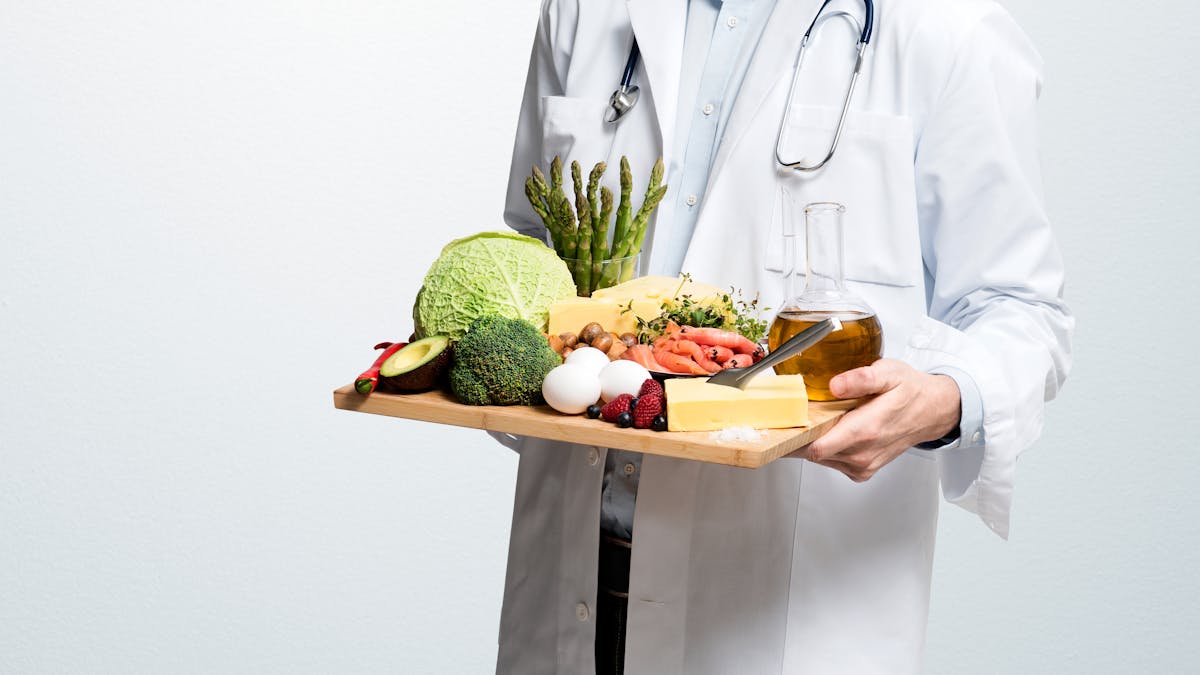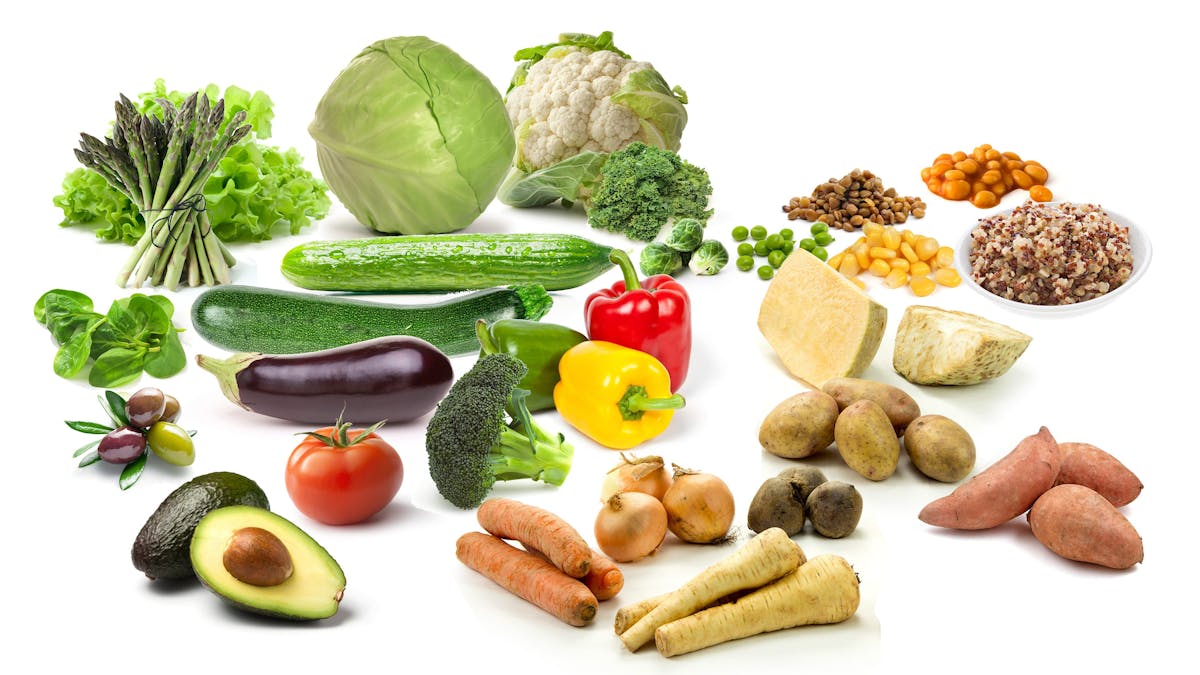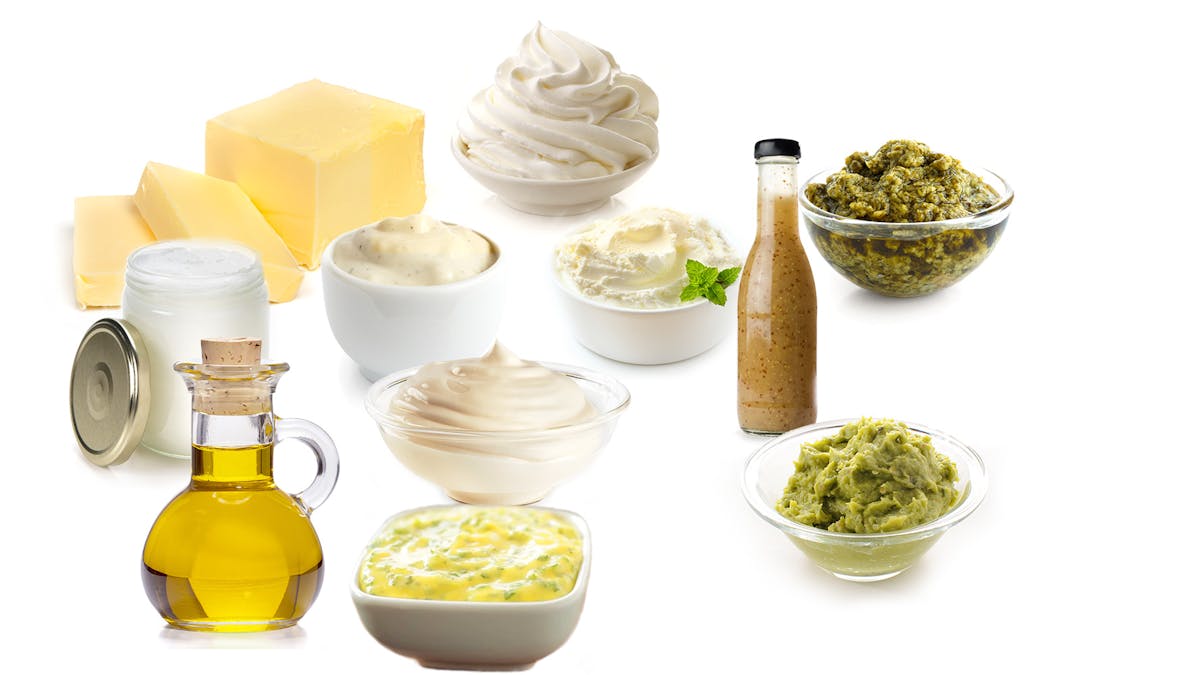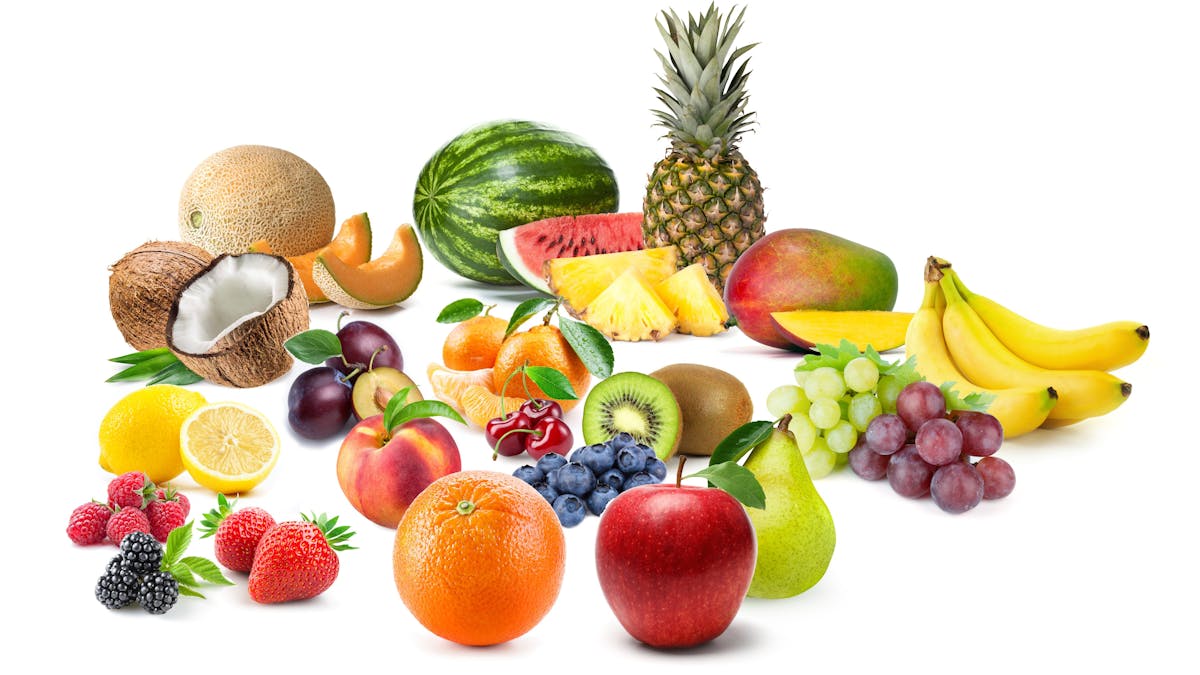The Diet Doctor food policy
Our goal, to empower people everywhere to revolutionize their health, reflects our belief that everyone is unique and may have different needs at different times. We hope you will find this policy helpful when you embark on your journey of finding out what foods work best for you.
Different levels of low carb1
Here’s how we define different levels of low carb at Diet Doctor:
- Ketogenic low carb <20 grams net carbs per day.2This level of carbohydrates is defined as below 5 energy percent (E%) carbs in our recipes or, if it is a meal, 7 grams of carbs or less. In our ketogenic recipes the amount of carbs per serving is shown in a green ball.
- Moderate low carb 20-50 net grams per day. This level is defined as between 5-10 E% carbs in our recipes and the amount of carbs per serving is shown in a yellow ball.
- Liberal low carb 50-100 net grams per day. This means 10-20 E% carbs in our recipes and the amount of carbs per serving is shown in an orange ball.
Carbohydrates (carbs)
We aim to provide recipes with 0–20 percent of the total energy coming from carbs, mainly from unprocessed whole food sources (e.g. vegetables).
Carbs are not essential to the human body, but if they come from unprocessed food they can contribute nutrients and fiber.34 They can also add variety to your diet and texture and color to your plate.
We show net carbs (total carbs minus dietary fiber) because in most people, fiber doesn’t cause a rise in blood glucose or insulin.5
Visual guide: Low-carb vegetables – the best and worst
Protein
We recommend meat, poultry, fish, seafood, eggs and/or dairy as the best sources of protein, preferably as unprocessed as possible.6
Protein is essential to the human body. Some people fear that amino acids from protein foods can be converted to glucose, thereby raising insulin levels. Although this occurs under experimental conditions, only a small percentage of amino acids are actually converted to glucose.7
People with type 2 diabetes usually do well with the adequate levels of protein Diet Doctor recommends, if their diets are also low carb.8 We recommend prioritizing your protein intake and focusing on foods that provide high nutrition at a lower calorie intake.
At Diet Doctor, we define adequate protein as 1.2 to 2.0 grams per kilo of reference body weight per day, or 15 to 35% of calories. This is the higher end of the US Institutes of Medicine definition, which sets 10% to 35% of calories as the acceptable range for protein intake.9
We believe most people would benefit by increasing their protein intake to 1.6 to 2.0 grams per kilo per day, or 25 to 35% of daily calories. Use this simple chart to find out what your minimum daily protein target should be, based on your height.10
Minimum daily protein target
| Height | Women | Men |
|---|---|---|
| Under 5’4″ ( < 163 cm) | 90 grams | 105 grams |
| 5’4″ to 5’7″ (163 to 170 cm) | 100 grams | 110 grams |
| 5’8″ to 5’10” (171 to 178 cm) | 110 grams | 120 grams |
| 5’11” to 6’2″ (179 to 188 cm) | 120 grams | 130 grams |
| Over 6’2″ (188 cm +) | 130 grams | 140 grams |
As the chart indicates, you should try to get around 100 grams if you’re a woman and 120 grams if you’re a man of average height and build. Eat more if you’re a man taller than 6 feet (183 cm) or a woman taller than 5’6″ (168 cm) or if you’re very physically active. Eat less if you’re shorter or have a very small frame.
Our complete guide provides much more information about the best high-protein foods to choose for weight loss.
Learn more about our policy on protein
Check out our guide about protein
Our high protein recipes
If a meal (lunch, dinner, or main course) has more than 25 energy percent (E%) protein and includes at least 30 grams (25 grams for breakfasts), we consider it a high protein meal.
For the rest of our recipes, such as desserts and bread, they need to have at least 25 E% protein per serving to be labeled as high protein.
These recipes are marked with a blue outline around the colored carb circle so you can easily spot them.
Learn more about why a higher protein diet could be beneficial for you in our practical guide.
All our high-protein recipes >
Fat
Some dietary fat is essential to the human body.11 We primarily recommend fat that’s part of natural foods such as fatty cuts of meat, eggs, and avocados over added oils and butter.12
Minimally processed added fats — such as butter, olive oil, and coconut oil — can be used in amounts needed to add flavor to your meals, and the extra calories may also help with satiety.13 However, they should still be seen as a modest part of one’s diet and not the main component due to their relative lack of protein and other essential nutrients.
Vegetable and seed oils (except olive or coconut oil) are often highly processed and high in omega-6 fats and, therefore, are not something we recommend. Examples of these non-recommended vegetable and seed oils are soybean oil, corn oil, and sunflower oil. In large quantities, omega-6 fats might potentially increase inflammation.14 These fats may also be less tolerant to heating, potentially forming harmful substances when used for frying.15 Processed fats such as margarine are not used on our site.
- Visual guide: Low-carb fats and sauces – the best and worst
- Learn more about fat
- Vegetable oils: What we know and what we don’t
Higher-carb ingredients
We see whole foods high in carbs, like potatoes and rice, as something that can be a part of a healthy diet in small to moderate amounts, for some people (especially if they are insulin sensitive).
However, such foods are high in carbs, reduce the effects of a low carb diet, and can be a problem for people who are more insulin-resistant.16 Therefore, we have chosen to not include potatoes and rice in our meal plans or recipes.
Certain seeds, like buckwheat and quinoa, are not something we recommend eating large amounts of, but are theoretically allowed in quantities that keep the recipes within our set limits for carbs. As a general rule, we don’t use them in our keto recipes.
Fruits and berries
We see fruits and berries as nature’s candy and something that can be a part of a healthy diet, in small to moderate amounts, for many people.17 However, fruit contains a large proportion of calories from sugar. Thus, people with insulin resistance or type 2 diabetes may want to limit their fruit intake to low-sugar, high-fiber sources such as raspberries.18
We aim to clearly mark recipes with a significant amount of sugar in them as moderate or liberal. This is to make it simple for people sensitive to sugar, such as people with diabetes, to take that into consideration.19
As a general rule, we avoid fruit in our keto recipes. Berries are usually a lower-carb option and are used in recipes as long as they stay within our set limits for carbs.
Additionally, although we occasionally use very small amounts of citrus juice in some of our recipes, we ensure that they fall within our established carb limits.
Avocados and olives are technically fatty fruits, although they are often grouped with vegetables. Because they contain very few net carbs, they are included in many of our keto recipes.
Visual guide: Low-carb fruits and berries – the best and worst
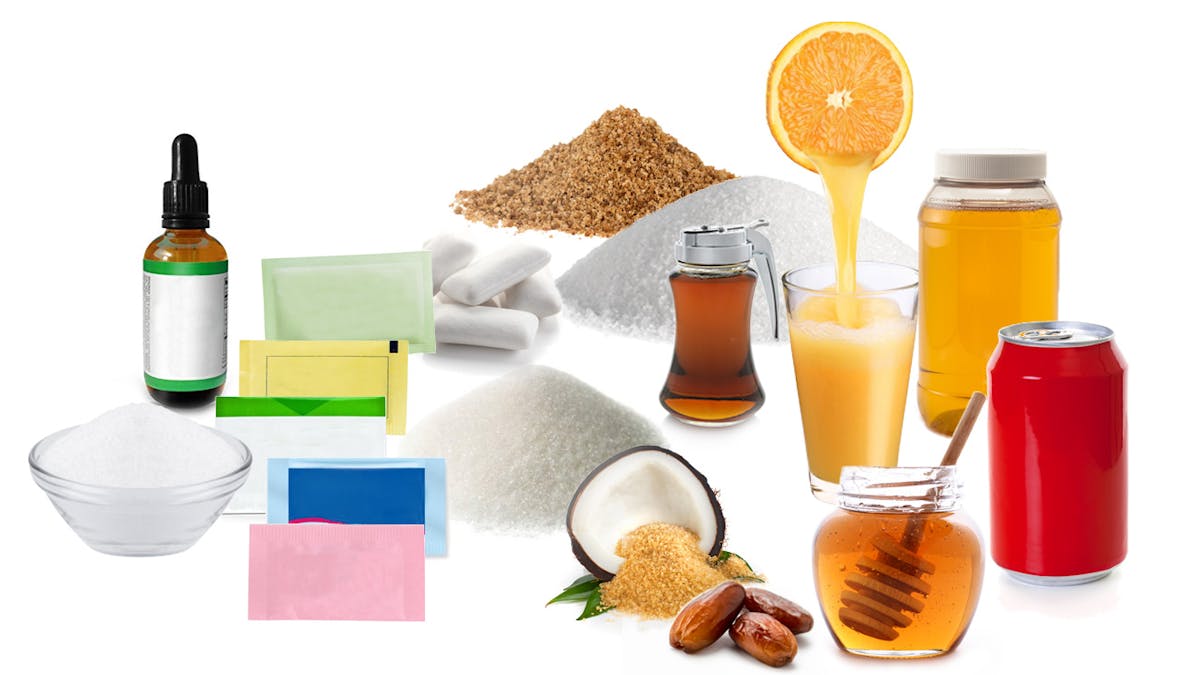
Sweeteners
We recommend minimizing the use of non-caloric sweeteners due to the potential for maintaining a preference for sweet tastes or stimulating over-consumption.20 Some people can also experience gastrointestinal problems when consuming them.21
Certain sweeteners that we deem potentially less harmful, such as erythritol and stevia, may be used mainly in our dessert and smoothie recipes.22
Visual guide: Low-carb sweeteners – the best and worst
Sugar
As a rule, we don’t use white sugar, brown sugar, honey, agave, or other sugars in our recipes because they don’t provide anything necessary for a healthy diet. However, we do use a small amount of sugar (no more than 1 teaspoon for an entire recipe) in a few of our bread recipes in order to activate the yeast.
Sugar raises blood glucose which causes insulin release, and it also has other potentially negative effects (see guide below).23
Learn more about sugar and its effects on your health
Gluten
In most of our recipes, we don’t use ingredients known to contain gluten because it can cause problems for people sensitive to it, even in small amounts.24
There is an exception for recipes that contain seitan (vital wheat gluten), a plant-based protein source. Any recipes with gluten will be clearly labeled as “This recipe contains gluten.”
We can’t guarantee that some ingredients used in our recipes (ground psyllium husk, oat fiber, and protein powder, etc.) haven’t been contaminated in production.25
However, we acknowledge that those who are not sensitive to gluten may be able to add it sparingly in low-carb diets.
Learn more about gluten and wheat
Gluten-free grains
Gluten-free grains, such as oats, are not something we recommend eating a lot of due to their high carb content.26
We do think that in small to moderate amounts, they can be part of a healthy diet for insulin-sensitive people. That’s why small amounts of gluten-free grains are allowed in our moderate and liberal low-carb recipes as long as they stay within our set limits for carbs. As a general rule, we don’t use them in our keto recipes.
However, some of our keto and low-carb recipes do contain oat fiber, which does not raise blood sugar and insulin levels because it is not digested and absorbed by your body.27
Dairy products
We use full-fat and low-fat dairy products such as butter, heavy whipping cream, yogurt, and cheese in our recipes unless they are marked as dairy-free.28 Many dairy products have a high protein content, which can increase satiety.29
Learn more about dairy on a low-carb diet
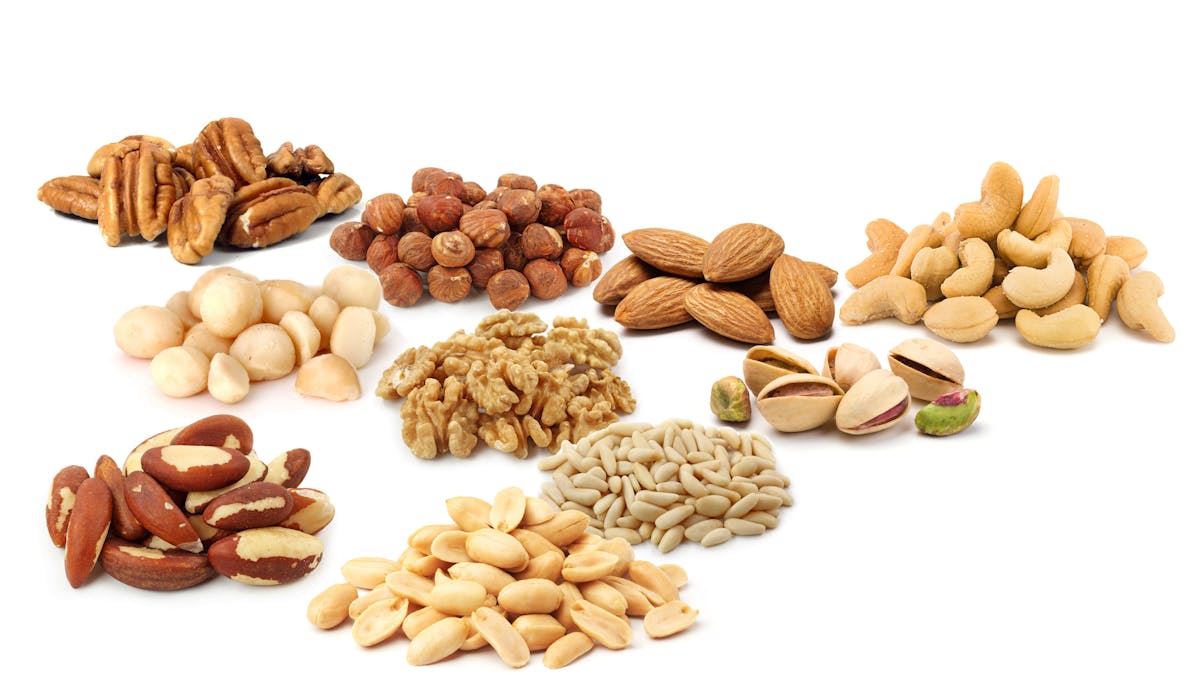
Nuts and seeds
Nuts and seeds are used in our recipes, both in their natural form and as flours. They add texture and flavor and can be used as a handy snack.30
The amount of carbs in different nuts and seeds varies quite a lot. They may be used in our recipes as long as they stay within our set limits for carbs.
Visual guide: Low-carb nuts – the best and worst
Meat
A healthy low-carb diet can, and often does, contain meat. But, it’s also possible to eat a meat-free low-carb diet.
We recognize that individuals have their own preference, and we aim to support people with guides and recipes whether they choose to eat meat or not.
The Diet Doctor policy on eating meat
Guide to red meat – is it healthy?
How to follow a healthy vegetarian keto diet
Legumes
Some legumes (also referred to as pulses) – such as beans, lentils, peas, and peanuts – are fairly high in carbs but are allowed in our recipes as long as the recipe itself stays within our set limits for carbs.
Legumes have varying amounts of resistant starch, which may have a lowering effect on blood sugar for some people, potentially mitigating the effects of the other carbohydrates somewhat.31
Learn more about resistant starch
Soy
Products made from soy, like tofu, can provide a good source of protein for vegetarians and vegans who follow a low-carb diet. However, concerns have been raised about the health effects of soy isoflavones based on animal and test-tube studies.32 By contrast, the research on soy in humans is mainly positive regarding safety and disease risk.33
Although soy doesn’t seem to cause problems for people with normal thyroid function, there’s been conflicting evidence in those with subclinical hypothyroidism (also known as mild thyroid failure).34
Soy isoflavones may interfere with thyroid hormone absorption when iodine intake isn’t sufficient.35 Therefore, it is important to get enough iodine when consuming soy regularly, especially for those with hypothyroidism. Good sources of iodine include iodized salt, seaweed, seafood, and yogurt.
At this time, some concerns remain about soy consumption in people with thyroid problems, as well as the long-term health effects of consuming ultra-processed soy protein powders and supplements.36 Choosing whole and/or fermented soy (tempeh, natto) might be a better option than other soy products. Also, people who take thyroid replacement should eat soy at least three hours before or one hour after taking their medication.
Some people have raised concerns that many soy products in the US may contain residues of glyphosate (Roundup), a controversial herbicide used on soy and other crops that requires further study.37 Fortunately, organic and non-GMO soy products contain no glyphosate.38 If you want to eat soy while avoiding glyphosate, choose tofu, tempeh, and natto labeled “non-GMO.”
For people who want to avoid animal products, the benefits of soy seem to greatly outweigh the risks. Although the potential risk to thyroid function appears very small, those who consume soy on a regular basis may want to consider having their thyroid function monitored periodically and including iodine food sources in their diet.
Guide: How to follow a healthy vegetarian keto diet
Chocolate
Dark chocolate with ≥70% cocoa solids (preferably ≥85%) and sugar-free chocolate may be used in our dessert recipes if they stay within our set limits for carbs. It’s only allowed in desserts and intended for occasional consumption, not in breakfast or snack recipes or in recipes that can be considered everyday foods.
However, unsweetened cocoa powder may be added to coffee or consumed as hot cocoa on a more frequent basis, as it contains a minimal amount of net carbs.39
High-oxalate foods
Oxalate is a compound found in many plants that we eat, like vegetables, nuts, and seeds. Foods especially high in oxalate include spinach and other leafy greens, beets, rhubarb, almonds, cocoa, sesame seeds, and sweet potatoes.
The body makes oxalate, too. In most people, roughly half of the oxalate eliminated in urine is produced by the body, and the remainder comes from dietary oxalate.40
After being absorbed, oxalate is usually eliminated from the body without any problem. However, in susceptible individuals, it can bind to calcium in the urinary tract and form kidney stones.
Because high amounts of urinary oxalate increase the risk of stone formation, people who are prone to forming calcium oxalate stones may need to avoid high-oxalate foods.41
However, there is a lack of convincing evidence that high-oxalate foods are harmful for people without a history of kidney stones. Therefore, we do not recommend that they restrict vegetables, nuts, and other nutritious low-carb foods that are high in oxalate.
Food policy - the evidence
This guide is written by Franziska Spritzler, RD and was last updated on June 17, 2022. It was medically reviewed by Dr. Bret Scher, MD on February 10, 2022.
The guide contains scientific references. You can find these in the notes throughout the text, and click the links to read the peer-reviewed scientific papers. When appropriate we include a grading of the strength of the evidence, with a link to our policy on this. Our evidence-based guides are updated at least once per year to reflect and reference the latest science on the topic.
All our evidence-based health guides are written or reviewed by medical doctors who are experts on the topic. To stay unbiased we show no ads, sell no physical products, and take no money from the industry. We're fully funded by the people, via an optional membership. Most information at Diet Doctor is free forever.
Read more about our policies and work with evidence-based guides, nutritional controversies, our editorial team, and our medical review board.
Should you find any inaccuracy in this guide, please email andreas@dietdoctor.com.
You may notice that we sometimes refer to % calories in our recipes. We find this helpful when creating a recipe, but when it comes to finding what works best for you, we recommend limiting your grams of carbohydrates, ensuring you get an adequate amount of protein, and adjusting your fat grams as needed for taste and satiety. ↩
Net carbs = digestible carbs, i.e. total carbs minus fiber. You can learn about net vs. total carbs in our dedicated guide. ↩
US Food and Nutrition Board’s 2005 textbook “Dietary Reference Intakes for Energy, Carbohydrate, Fiber, Fat, Fatty Acids, Cholesterol, Protein, and Amino Acids”, stated that:
“The lower limit of dietary carbohydrate compatible with life apparently is zero, provided that adequate amounts of protein and fat are consumed.”
Learn more: Food for thought: Does the brain need carbs? ↩
Advances in Nutrition 2012: Health benefits of fruits and vegetables [overview article] ↩
Although some low carb experts disagree, it’s generally accepted that humans lack the enzymes needed to break down fiber and absorb it into the bloodstream. Therefore, the fiber portion of carbs does not raise blood sugar and insulin levels:
Nutrients 2010: Effects of dietary fiber and its components on metabolic health [overview article] ↩
In addition to containing fewer carbs than most plant sources of protein, animal protein is considered higher quality because it contains all 9 essential amino acids – the ones your body can’t make on its own – in optimal amounts:
Journal of Cachexia, Sarcopenia and Muscle 2017: Dietary protein content for an optimal diet: a clinical view [overview article]
Scientific Reports 2016: Essential amino acids: master regulators of nutrition and environmental footprint? [overview article]
↩Diabetes 2013: Dietary proteins contribute little to glucose production, even under optimal gluconeogenic conditions in healthy humans [nonrandomized trial; weak evidence] ↩
Gluconeogenesis is a demand-driven process that occurs whenever glucose is needed. For instance, when someone follows a carb-free diet, gluconeogenesis will provide glucose for the few parts of the body that can’t use ketones: red blood cells and portions of the kidney and brain:
American Journal of Clinical Nutrition 2009: Gluconeogenesis and energy expenditure after a high-protein, carbohydrate-free diet [moderate evidence]
Very high protein intake on a keto or low-carb diet may also lead to gluconeogenesis:
Diabetologia 2000: Effect of long-term dietary protein intake on glucose metabolism in humans [moderate evidence]
However, clinically this does not appear to be an issue, as other studies show no negative effect on blood sugar or insulin levels:
The trials included in this review of RCTs did not restrict protein intake and showed significant improvement in blood glucose levels and metabolic health:
BMJ Open Diabetes Research and Care: Systematic review and meta-analysis of dietary carbohydrate restriction in patients with type 2 diabetes [strong evidence]
In addition, two studies showed that a diet with 30% of calories from protein improved glycemic control:
Diabetes 2004: Effect of a high-protein, low-carbohydrate diet on blood glucose control in people with type 2 diabetes [randomized trial; moderate evidence]
American Jopurnal of Clinical Nutrition 2003: An increase in dietary protein improves the blood glucose response in persons with type 2 diabetes [randomized trial; moderate evidence]
The difference may be because although protein may increase insulin concentrations acutely, high protein diets are not known to cause hyperinsulinemia (chronically high insulin levels):
Diabetes care 2003: Amino acid ingestion strongly enhances insulin secretion in patients with long-term type 2 diabetes. [nonrandomized trial; weak evidence]
↩Institute of Medicine of the National Academies 2005: Dietary Reference Intakes for energy, carbohydrate, fiber, fat, fatty acids, cholesterol, protein, and amino acids[overview article; ungraded]
Journal of the American Dietetic Association 2002: Dietary reference intakes for energy, carbohydrate, fiber, fat, fatty acids, cholesterol, protein and amino acids
[overview article; ungraded]Controversy exists about how they derived the upper number, as it uses nitrogen balance and is not based on clinical outcomes and is therefore theoretical and the true number may be even higher:
Journal of Nutrition 2003: Amino acid pharmacokinetics and safety assessment
[overview article; ungraded]But even 35% may be low when it comes to how much protein the body can process without harm. Based on calculations of the liver and kidney’s ability to safely handle protein, a 176-pound (80-kilo) person has a theoretical maximum of 365 grams of protein per day:
International Journal of Sports Nutrition and Exercise Metabolism 2006: A review of issues of dietary protein intake in humans
[overview article; ungraded]
↩In this case, height is a proxy for reference body weight. Reference body weight is a way of estimating how much lean body mass a person of a specific height would have and thus how much protein they need on a daily basis. ↩
While we recommend consuming adequate amounts of good-quality fat, technically only alpha-linolenic (omega-3) and linoleic (omega-6) fatty acids are essential, meaning they must be consumed in the diet because your body can’t make them:
Journal of Dietary Supplements 2009: The essentials of essential fatty acids [overview article]
↩The reason is that these foods have significantly higher levels of essential nutrients, compared to added fats. ↩
Many natural fat sources are high in saturated fatty acids. This should no be longer considered harmful, as modern science has shown saturated fat to be more or less neutral from a health perspective:
Annals of Nutrition & Metabolism 2009: Dietary fat and coronary heart disease: summary of evidence from prospective cohort and randomised controlled trials [strong evidence]
Open Heart 2015: Evidence from randomised controlled trials did not support the introduction of dietary fat guidelines in 1977 and 1983: a systematic review and meta-analysis [strong evidence] ↩
However, results from controlled trials investigating a relationship between omega-6 fatty acids and inflammation have been mixed. Further research in this area is needed:
Prostaglandins, Leukotrienes & Essential Fatty Acids 2018: Omega-6 fatty acids and inflammation [overview article]
↩Indian Journal of Clinical Biochemistry 2000: Lipid peroxidation in culinary oils subjected to thermal stress [moderate evidence] ↩
Nutrition & Metabolism 2017: Hepatic, adipocyte, enteric and pancreatic hormones: response to dietary macronutrient composition and relationship with metabolism [moderate evidence] ↩
People with type 2 diabetes often do better on a very low-carb diet:
Diabetes Research and Clinical Practice 2018: Effect of dietary carbohydrate restriction on glycemic control in adults with diabetes: A systematic review and meta-analysis [strong evidence] ↩
Studies have found that people with diabetes achieve better blood sugar and insulin control when consuming keto diets that contain minimal to no fruit vs. diets that contain moderate amounts of fruit:
Nutrition & Metabolism 2008: The effect of a low-carbohydrate, ketogenic diet versus a low-glycemic index diet on glycemic control in type 2 diabetes mellitus [moderate evidence]
Nutrition & Diabetes 2017: Twelve-month outcomes of a randomized trial of a moderate-carbohydrate versus very low-carbohydrate diet in overweight adults with type 2 diabetes mellitus or prediabetes [moderate evidence]
Journal of Medical Internet Research 2017: An online intervention comparing a very low-carbohydrate ketogenic diet and lifestyle recommendations versus a plate method diet in overweight individuals with type 2 diabetes: a randomized controlled trial [moderate evidence]
↩At this time, research remains inconclusive regarding the effects of sweeteners on appetite, cravings, and overeating:
Nutrition Journal 2017: Health outcomes of non-nutritive sweeteners: analysis of the research landscape [strong evidence]
However, many people have reported experiencing these effects when consuming artificial sweeteners:
Nutrients 2018: The impact of caloric and non-caloric sweeteners on food intake and brain responses to food: a randomized crossover controlled trial in healthy humans [moderate evidence]
The American Journal of Clinical Nutrition 2015: Effects on weight loss in adults of replacing diet beverages with water during a hypoenergetic diet: a randomized, 24-wk clinical trial [moderate evidence] ↩
This includes potential changes to the gut microbiome:
Advances in Nutrition 2019: Effects of sweeteners on the gut microbiota: a review of experimental studies and clinical trials [strong evidence] ↩
Stevia and erythritol have minimal, if any, effects on blood sugar and insulin levels. They are generally considered safe and well-tolerated when used in small amounts on an occasional basis:
American Journal of Physiology, Endocrinology & Metabolism 2016: Gut hormone secretion, gastric emptying, and glycemic responses to erythritol and xylitol in lean and obese subjects [moderate evidence]
European Journal of Clinical Nutrition 2015: Gastrointestinal tolerance of erythritol-containing beverage in young children: a double-blind, randomised controlled trial [moderate evidence]
Current Pharmaceutical Design 2017: A review on the pharmacology and toxicology of steviol glycosides extracted from Stevia rebaudiana [overview article]
Clinical Therapeutics 2003: Efficacy and tolerability of oral stevioside in patients with mild essential hypertension: a two-year, randomized, placebo-controlled study [moderate evidence] ↩
Keep in mind that sugar is sugar. “Natural” sugars like honey have been shown to raise blood glucose and insulin levels as much as white sugar and high-fructose corn syrup:
Journal of Nutrition 2015: Consumption of honey, sucrose, and high-fructose corn syrup produces similar metabolic effects in glucose-tolerant and -intolerant individuals [weak evidence]
↩This may be true both for people with celiac disease and those with non-celiac gluten sensitivity.
Nutrients 2016: Evidence for the presence of non-celiac gluten sensitivity in patients with functional gastrointestinal symptoms: results from a multicenter randomized double-blind placebo-controlled gluten challenge [moderate evidence]
Nutrients 2019: Exposure to different amounts of dietary gluten in patients with non-celiac gluten sensitivity (NCGS): an exploratory study [weak evidence]
↩If you have celiac disease or are gluten sensitive, you may want to purchase ingredients that are certified or verified gluten-free. ↩
Furthermore, some inherently gluten-free grains, seeds, and flours (e.g. oats, millet flour, soy flour) not labeled gluten-free might sometimes be contaminated with gluten while being harvested, transported, and/or processed.
This potential risk of contamination could be a health concern for gluten-sensitive people:
Journal of the American Dietetic Association 2010: Gluten contamination of grains, seeds, and flours in the United States: a pilot study [moderate evidence] ↩
Humans lack the enzymes needed to break down fiber and absorb it into the bloodstream. Therefore, the fiber portion of carbs does not raise blood sugar and insulin levels:
Nutrients 2010: Effects of dietary fiber and its components on metabolic health [overview article] ↩
The fear of saturated fats, like those in dairy, appears to have been completely misguided:
Nutrition Journal 2017: The effect of replacing saturated fat with mostly n-6 polyunsaturated fat on coronary heart disease: a meta-analysis of randomised controlled trials [strong evidence] ↩
Studies suggest that consuming dairy products may help people achieve and maintain a healthy weight by promoting satiety and reducing overall food intake:
Clinical Nutrition 2017: Dairy products, satiety and food intake: a meta-analysis of clinical trials [strong evidence]
Nutrients 2016: Regular-fat dairy and human health: a synopsis of symposia presented in Europe and North America (2014-2015) [overview article] ↩
Nuts also contain several micronutrients and may have generally positive health effects:
Nutrients 2017: Nuts and human health outcomes: a systematic review [strong evidence] ↩
Resistant starch “resists” digestion in the intestinal tract and instead passes directly into the colon, where bacteria ferment it into short-chain fatty acids that may potentially improve blood glucose regulation.
Note, however, that the studies below used large amounts of resistant starch (10 or 30 grams per day). It may be unpractical to get as much resistant starch from legumes, that usually contain about 1-4 grams of resistant starch per 100 grams:
Nutrition Journal 2017: Resistant starch lowers postprandial glucose and leptin in overweight adults consuming a moderate-to-high-fat diet: a randomized-controlled trial [moderate evidence]
Complementary Therapies in Medicine 2015: Is there any place for resistant starch, as alimentary prebiotic, for patients with type 2 diabetes? [moderate evidence]
European Journal of Nutrition 2016: Effects of total fibre or resistant starch-rich diets within lifestyle intervention in obese prediabetic adults [moderate evidence] ↩
Isoflavones are a type of phytoestrogen (plant compounds that have a structure similar to estrogen) found in soy and other legumes. ↩
This is true for observational studies spanning many years as well as shorter but much higher-quality clinical trials:
Advances in Nutrition 2018: Associations between phytoestrogens, glucose homeostasis, and risk of diabetes in women: a systematic review and meta-analysis [systematic review of randomized trials; strong evidence]
PloS One 2013: Soy, red clover, and isoflavones and breast cancer: a systematic review [systematic review of randomized trials; strong evidence]
Gynecological Endocrinology 2013: Endometrial, breast and liver safety of soy isoflavones plus Lactobacillus sporogenes in post-menopausal women [randomized trial; moderate evidence]
Reproductive Toxicology 2020 Neither soy nor isoflavone intake affects male reproductive hormones: An expanded and updated meta-analysis of clinical studies [review of nonrandomized studies, weak evidence]
Nutrients 2018: Soy, soy foods, and their role in vegetarian diets [overview article; ungraded] ↩
Scientific Reports 2019: Systematic review and meta-analysis on the effect of soy on thyroid function [strong evidence]
EFSA Journal 2015: Risk assessment for peri- and post-menopausal women taking food supplements containing isolated isoflavones [systematic review of clinical studies; strong evidence]
The Journal of Clinical Endocrinology & Metabolism 2011: The effect of soy phytoestrogen supplementation on thyroid status and cardiovascular risk markers in patients with subclinical hypothyroidism: a randomized, double-blind, crossover study [moderate evidence]
Journal of the Endocrine Society 2017: Soy protein improves cardiovascular risk in subclinical hypothyroidism: a randomized double-blinded crossover study [moderate evidence]
Frontiers in Endocrinology 2017: The effect of phytoestrogen on thyroid in subclinical hypothyroidism: randomized, double blind, crossover study [moderate evidence] ↩
Thyroid 2006: Effects of soy protein and soybean isoflavones on thyroid function in healthy adults and hypothyroid patients: a review of the relevant literature [overview article; ungraded] ↩
Alternative Therapies in Health & Medicine 2014: Soy foods and supplementation: a review of commonly perceived health benefits and risks [overview article; ungraded] ↩
Archives of Toxicology 2017: Glyphosate toxicity and carcinogenicity: a review of the scientific basis of the European Union assessment and its differences with IARC [expert review; ungraded] ↩
After testing 31 batches of soybeans, researchers found that unlike genetically-modified soybeans, conventional and organic soybeans contained no glyphosate:
Food Chemistry 2014: Compositional differences in soybeans on the market: Glyphosate accumulates in Roundup Ready GM soybeans [mechanistic study; ungraded] ↩
Some studies suggest it might even have benefits for heart and gut health:
Journal of Nutrition 2016: Cocoa flavanol intake and biomarkers for cardiometabolic health: a systematic review and meta-analysis of randomized controlled trials [strong evidence]
American Journal of Clinical Nutrition 2011: Prebiotic evaluation of cocoa-derived flavanols in healthy humans by using a randomized, controlled, double-blind, crossover intervention study [moderate evidence]
↩American Journal of Physiology. Renal Physiology 2019: Dietary oxalate and kidney stone formation
[overview article; ungraded] ↩American Journal of Physiology. Renal Physiology 2019: Dietary oxalate and kidney stone formation
[overview article; ungraded] ↩
